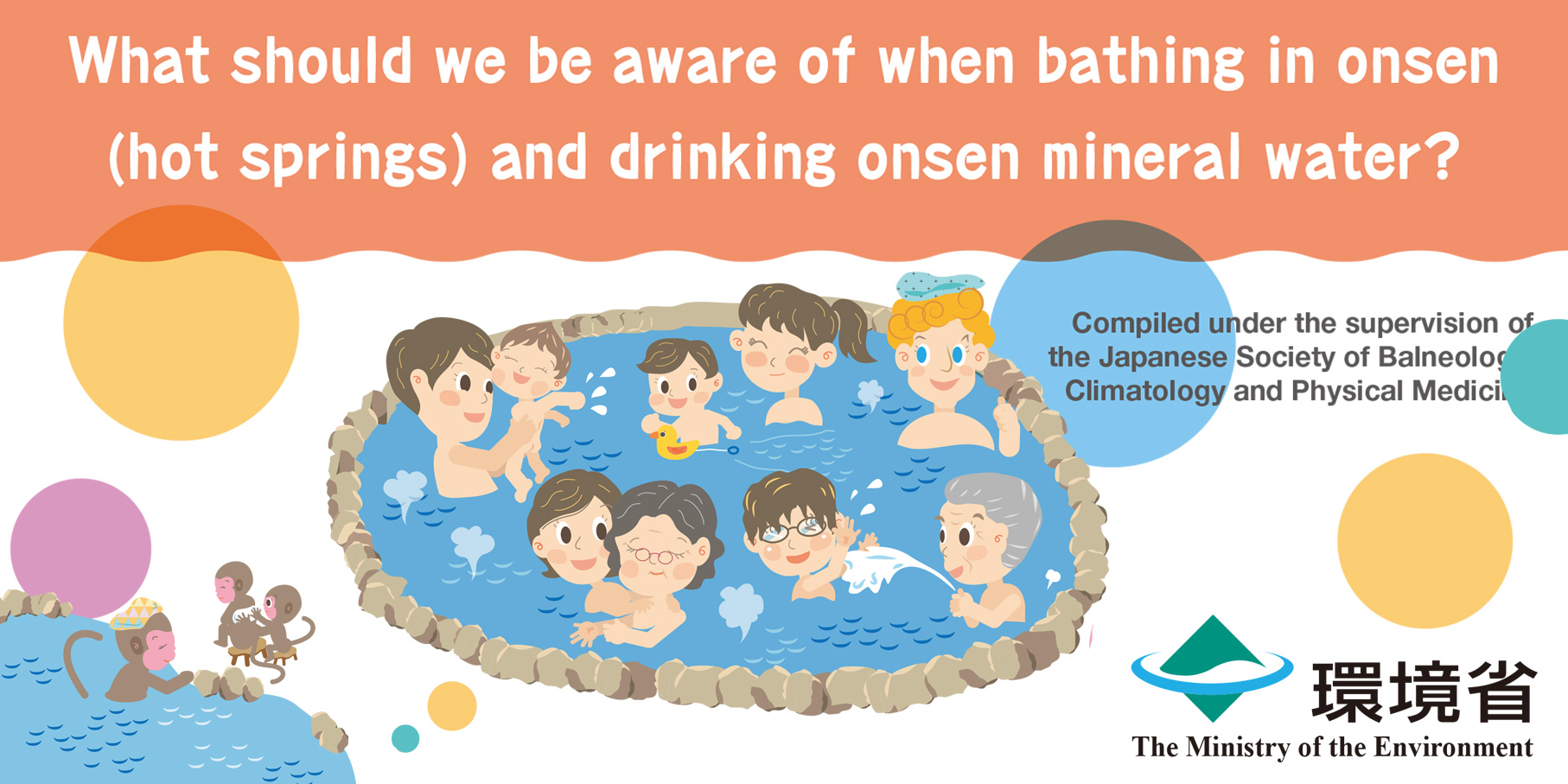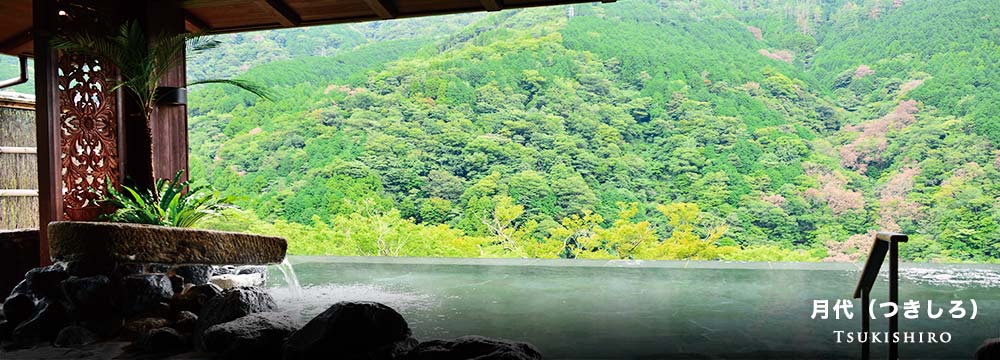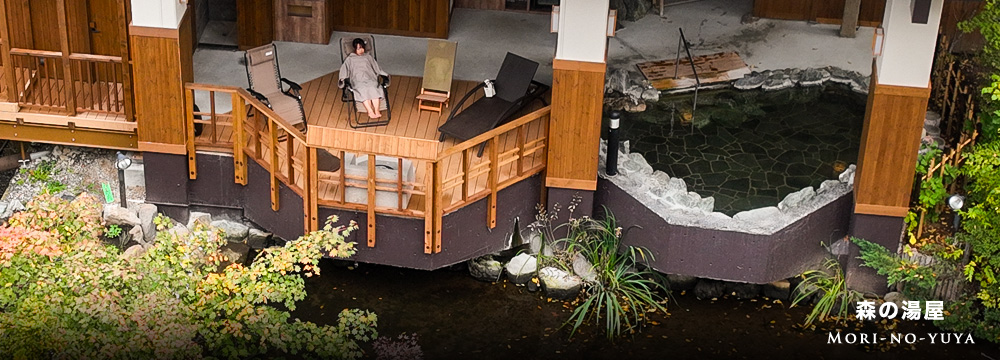
OTARU KOURAKUEN
| Weak Alkaline Simple Hot Springs | pH |
|
| 弱アルカリ性単純温泉(低張性 弱アルカリ性 低温泉) | ||
| (Hypotonic, Weak Alkaline, Low temperature springs) | ||
| 旧泉質名:単純温泉 | ||
Ideal for people like this
- Those who are not good with stimulating hot spring
- Those with sleep disorders
- Those who are feeling stressed
- Those undergoing post-illness rehabilitation
- Address
- 5-18-2 Shinko, Otaru City, Hokkaido, 047-0152, JAPAN
- Phone
- +81-(0)134-54-8221

Official Website

Travel Journal
Hot Spring Power Chart (5-point scale)
Hydrogen Ion Concentration (pH)

- Comment
- Hot spring for beautiful skin with little stimulation
Hot spring Specification
※This is an easy-to-understand expression based on the indications for each type of spring in the "Guideline to the Mineral Spring Analysis Methods" revised in July 2014 by the Ministry of the Environment.
| ①Mental recovery | ②Insomnia | ③Promote blood circulation | ④Sensitivity to cold | ⑤Dry skin |
| ⑥Cuts | ⑦Skin diseases | ⑧Hypertension (mild) | ⑨Heartburn (drinking) | ⑩Gastrointestinal disorders (drinking) |
| ⑪Constipation (drinking) | ⑫Lifestyle-related disease | ⑬Diabetes | ⑭Gout | ⑮Countermeasures against metabolic syndrome |
| ⑯Biliary system anxiety | ⑰Anaemia | ⑱Arthritis rheumatica | ⑲Spinal pain | ⑳Improved immunity |
| ㉑Muscle pain・Neuralgia | ㉒Mild asthma | ㉓Hemorrhoidal pain | ㉔Recovery from an illness | ㉕Recovery from fatigue |
- ※Note①・・・Indications for each spring include autonomic instability and depression.(Simple springs・Chloride springs・Carbon dioxide springs)
- ※Note③・・・Indications for each spring include peripheral circulatory failure(Chloride springs・Carbonate springs・Carbon dioxide springs・Hydrogen sulfide type sulphur spring)
- ※Note④・・・Indications for each spring include sensitivity to cold(Chloride springs・Carbonate springs・Sulfur springs・Carbon dioxide springs)and Iron containing springs
- ※Note⑦・・・Indications for each spring include xeroderma, atopic dermatitis, plaque psoriasis, epidermoid suppuration, chronic eczema(Chloride springs・Carbonate springs・Sulfate spring・Acidic springs・Sulfur springs)
- ※Note⑨・・・Indications for drinking each spring include reflux esophagitis(Carbonate springs)
- ※Note⑩・・・Indications for drinking each spring include atrophic gastritis, gastroduodenal ulcerations(Chloride springs・Carbonate springs)
- ※Note⑪・・・For drinking, Chloride springs and Sulfate spring
- ※Note⑫・・・Indications for each spring include hypercholesterolemia, diabetes, gout(for bathing, Acidic springs・Radioactive springs/for drinking, Carbonate springs・Iodine containing springs・Sulfur springs)
- ※Note⑮・・・Indications for drinking each spring include hypercholesterolemia(Sulfate spring・Iodine containing springs・Sulfur springs)
- ※Note⑱⑲・・・Indications for each spring include rheumatoid arthritis, ankylosing spondylitis(Radioactive springs)
- ※Note⑳・・・Radioactive springs
- ※Note㉑㉔・・・Simple hot spring water is suitable for rehabilitation due to its low level of stimulation, and although it is not listed as an indication by spring quality, it is also called "Hot springs for neuralgia" and "Hot springs for stroke".
| Applicable to indications by spring quality | Applicable to general indications |
7 Elements of Hot Springs for Beautiful Skin
Total 1 Points ※The number of points represents the quality of the "Hot springs for beautiful skin".
| Skin cleansing effect | Skin reviving effect | Skin whitening effect |
|---|---|---|
| Carbonate Springs | Sulfate Springs | Sulfur Springs |
| Skin smoothing effect | Skin Coating and moisturizing effect | Skin moisturizing effect | Cleaning Effects |
|---|---|---|---|
| Weak alkaline | Chloride | Metasilicic acid (100mg/kg) |
Metaboronic acid (10mg/kg) |
- ※The "Four Best Beauty Springs" are said to be "Carbonate springs", "Sulfate springs", "Sulfur springs", and "(Weak) Alkaline simple hot springs".
- ※The "Chloride springs" coats the skin with a salt pack, keeping it warm and moisturized at the same time. It is also called "Hot springs for finishing touch" to be taken after the "Hot spring for beautiful skin" in which exfoliation has been removed.
- ※Hot springs containing 100 mg/kg or more of metasilicicic acid have an excellent moisturizing effect and is said to be "Hot springs for beautiful skin".
- ※Hot springs containing 10 mg/kg or more of metaboric acid have a cleansing effect, is used in some eye drops, and is said to be effective in treating acne.
Water texture while bathing(5-point evaluation)
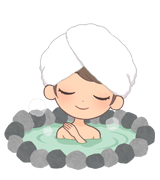
| Smoothly | Mushy | ||||||||||
|---|---|---|---|---|---|---|---|---|---|---|---|
| Powdery | Chewy | ||||||||||
| Fizzy | Tingling | ||||||||||
Skin feeling after bathing(5-point evaluation)
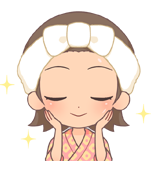
| Silky | Dryness | ||||||||||
|---|---|---|---|---|---|---|---|---|---|---|---|
| Powdery | Sticky | ||||||||||
| Moistly | Warmly | ||||||||||
View from the open-air bath(5-point evaluation)
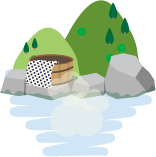
| Japanese garden with a pond Snow-viewing in winter |
| Men's and women's public baths "Mori-no-Yuya" |
| Point 4 |
|---|
Hot Spring Source Usage
| Water added No |
Heated No |
Disinfected No |
Circulated No |
Bath additive No |
|---|---|---|---|---|
| △ | × | × | × | ○ |
| ※Because the temperature of the source is low and the amount of water gushing out is small, heating and circulating filtration are used for sanitary management. ※Of the one-hour period, 45 minutes is circulation only, but for 15 minutes, new hot spring water is poured into the bathtub at the same time (combined use of source water and circulation/filtration). ※Basically, it is 100% natural spring water from the source without addition of water, but a few percent of the spring water on the premises is used when changing the hot water. |
||||
| Percentage of hot spring source | Almost 100% | ||||
|---|---|---|---|---|---|
| Replacement frequency of hot spring water | Once every week | ||||
| Yield of hot spring water | Private source of power pumping hot water (pumped from 500 m underground) | ||||
| Distance from the source to the bathtub | About 100m(Gushing on the property) | ||||
| How hot spring water is drawn | Drawn by a pipe | ||||
| How water temperature is adjusted | Heating and adjusting as needed | ||||
| Drinking Spring | None | ||||
| “Gensen-Kakenagashi” Bath | None | ||||
Hot Spring Composition Table Hot Spring Analysis Report
| Spring Quality | Weak Alkaline Simple Hot Springs (Hypotonic, Weak Alkaline, Low temperature hot spring) 旧泉質名:単純温泉 |
|---|---|
| Color of hot spring | Almost colorless and transparent |
| Scent of hot spring | Odorless |
| Dissolved substances | 404mg/kg(Sum of components (1) + (2) + (3), excluding gaseous substances) |
| Temperature of spring | 25.4℃ |
| pH | 8.4(Weak Alkali) |
| Yield | About 60 liters per minute Amount of hot spring use per person (yield / bath capacity):About 0.447 liters/person(maximum capacity of 134 people) |
Hot Spring Composition (Amount contained in 1 kg of spring)
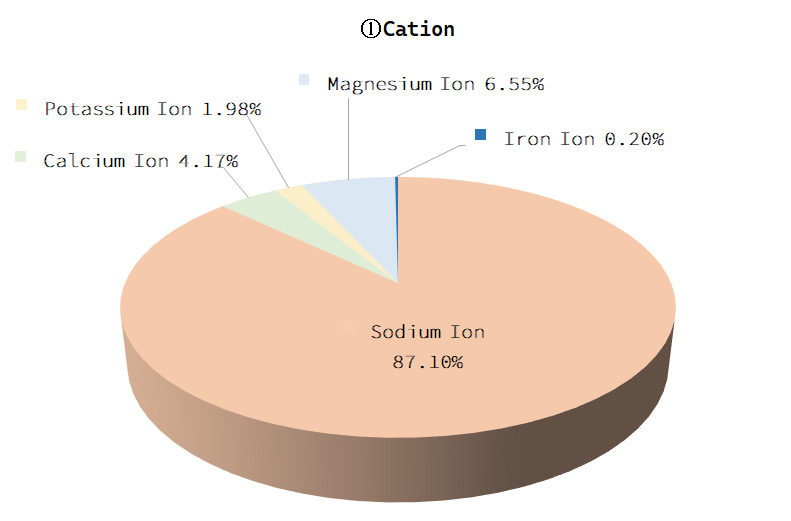 |
|||
|---|---|---|---|
| ①Cation | mg | mval | mval% |
| Sodium Ion(Na+) | 101.0 | 4.39 | 87.10 |
| Potassium Ion(K+) | 4.1 | 0.10 | 1.98 |
| Calcium Ion(Ca2+) | 4.2 | 0.21 | 4.17 |
| Magnesium Ion(Mg2+) | 4.0 | 0.33 | 6.55 |
| Iron Ion(Fe3+) | 0.2 | 0.01 | 0.20 |
| Cations Total(1) | 113.5 | 5.04 | 100.00 |
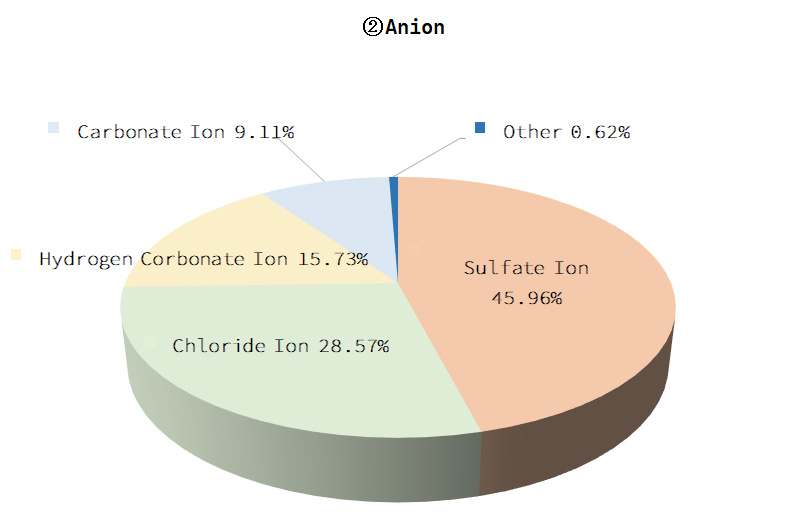 |
|||
|---|---|---|---|
| ②Anion | mg | mval | mval% |
| Sulfate Ion(SO42-) | 106.8 | 2.22 | 45.96 |
| Chloride Ion(Cl-) | 48.8 | 1.38 | 28.57 |
| Hydrogen Carbonate Ion(HCO3-) | 46.4 | 0.76 | 15.73 |
| Carbonate Ion(CO32-) | 13.2 | 0.44 | 9.11 |
| Phosphate Ion(HPO42-) | 0.2 | 0.00 | 0.00 |
| Fluoride Ion(F-) | 0.6 | 0.03 | 0.62 |
| Anions Total(2) | 216.0 | 4.83 | 100.00 |
| Undissociated Components | mg | mmol | |
|---|---|---|---|
| Metasilicic Acid(H2SiO3)★ | 74.4 | 0.95 | |
| Metaboric Acid(HBO2) | 0.50 | 0.01 | |
| Undissociated Components Total(3) | 74.90 | 0.96 | |
| Dissolved Gas Components | mg | mmol | |
|---|---|---|---|
| Free Carbon Dioxide(CO2) | 0.30 | 0.01 | |
| Dissolved Gas Components Total(4) | 0.30 | 0.01 | |
| Other Trace Components | |||
|---|---|---|---|
| Aluminum Ions:0.01mg/kg, Total Arsenic(As):0.006mg/kg Aluminum ion, Manganese ion, Cadmium ion, Lead ion, Copper ion, Zinc ion and Total mercury: Not detected |
★are the ingredients related to the "spring quality" and the ingredients that qualify conditions for "hot spring" and "therapeutic hot spring".
Indications for Bathing (Revised on July 1, 2014)
Indications by Spring Quality for Bathing
Autonomic instability, Insomnia, Depression
General Indications for Bathing
Chronic pain or stiffness of muscles or joints (chronic phase of rheumatoid arthritis, osteoarthritis, lower back pain, neuralgia, frozen shoulder, bruises, sprains, etc.),
muscle stiffness by motor paralysis, sensitivity to cold, peripheral circulatory disturbance,
gastrointestinal hypofunction (slow digestion, intestinal gas formation, etc.),
mild hypertension, impaired glucose tolerance (diabetes), mild hypercholesterolemia,
mild asthma or emphysema, pains of hemorrhoidals, autonomic instability,
various symptoms from stress (sleep disorders, depression, etc.),
restorative phase from illness, recovery from fatigue, health promotions
Contraindications by Spring Quality for Bathing
None
General Contraindications for Bathing
Active stage of diseases (especially when fever is accompanied), active tuberculosis,
advanced malignant tumor, or the case of significant debility involving severe anemia,
severe cardiac or lung diseases involving suffocation feelings with a little movement,
severe kidney disease involving edema, gastrointestinal bleeding,
when there is visible bleeding, acute exacerbation stage of chronic diseases, etc.
Indications by Spring Quality for Drinking
Not drinkable ※Non-submission of application for drinking to the health department
Date of Analysis (The above hot spring composition table is cited from the survey data of the following institution)
May 14, 2012 (Hokkaido Pharmaceutical Association Public Health Examination Center)
- ※Indications and contraindications for hot springs are in accordance with "Guideline to the Mineral Spring Analysis Methods" revised on July 1, 2014.
- ※Data was provided by the ryokan.
20 qualifications for "Hot springs" and 8 qualifications for "Therapeutic hot springs"
| Conditions/Components (contained amount in 1kg) ※If even one of the conditions is cleared, it is a "Hot springs" or "Therapeutic hot springs" |
A【Hot Springs Act】 Conditions of the "Hot springs" |
B【Guideline to the Mineral Spring Analysis Methods】 Conditions of the "Therapeutic hot springs" |
|
|---|---|---|---|
| 1 | Temperature (when collected from source) | 25℃ or higher | |
| 2 | Dissolved substances (excluding gaseous) | Total amount 1,000mg or more | |
| 3 | Free carbon dioxide (CO2) | 250mg or more | 1000mg or more (Carbon dioxide springs) |
| 4 | Lithium ion (Li+) | 1mg or more | ― |
| 5 | Strontium ion (Sr2+) | 10mg or more | ― |
| 6 | Barium ion (Ba2+) | 5mg or more | ― |
| 7 | Total Iron Ion[Fe2+(Iron(Ⅱ) Ferro ion)+Fe3+(Iron(Ⅲ) Ferri ion)] | 10mg or more | 20mg or more(Iron containing springs) |
| 8 | First manganese ion (Mn2+) | 10mg or more | ― |
| 9 | Hydrogen ion (H+) | 1mg or more | 1mg or more (Acidic springs) |
| 10 | Bromine ion (Br-) | 5mg or more | ― |
| 11 | Iodide ion (I-) | 1mg or more | 10mg or more (Iodine containing springs) |
| 12 | Fluoride ion (F-) | 2mg or more | ― |
| 13 | Hydro Arsenate Ion (HAsO42-) | 1.3mg or more | ― |
| 14 | Meta Arsenite (HAsO2) | 1mg or more | ― |
| 15 | Total sulfur (S) [HS-(Hydrogen sulfide ion)+S2O32-(Thiosulfate Ion)+H2S(Free hydrogen sulfide)] | 1mg or more | 2mg or more (Sulfur springs) |
| 16 | Metaboric Acid (HBO2) | 5mg or more | ― |
| 17 | Metasilicic acid (H2SiO3) | 50mg or more | ― |
| 18 | Bicarbonate soda (NaHCO3) | 340mg or more | ― |
| 19 | Radon (Rn) | 20 or more (unit: ten ppb curie) 20×10-10Ci(curie) or more 20 or more(ten ppb curie) =74Bq(becquerel) / 5.5mache or more |
30 nanocurie or more (Radioactive springs) 30×10-10Ci(curie) or more 30 or more(ten ppb curie) =111Bq(becquerel) / 8.25 macheor more |
| 20 | Radium salt (as Ra) | 10-8mg or more 1/100 million mg or more |
― |
| Number of conditions cleared this "hot spring" or "therapeutic hot spring" is: | 2 (out of 20) | 1 (out of 8) | |
| Total 3 Points | |||
※Conditions called "Hot springs" in Japan are expressed in terms of number of points.
Hot Spring Legends and More
Traditionally documented efficacies
ー
Historical figures who bathed in this hot spring
ー
Celebrities who bathed in this hot spring
Author・Mr.Makoto Shiina, Musician・Mr.Chiharu Matsuyama, Actor・Mr.Yo Oizumi, Former Sumo wrestler・Ozeki Konishiki, Professional golfer・Mr.Ryo Ishikawa etc. Numerous celebrities have visited
Hot Spring (Onsen) Report
Otaru Kourakuen has its own private source of spring on the premises. The advantage of private hot springs is
that the distance between the spring and the bathtub is shorter, which reduces the chance of impurities mixing
with the hot spring water before it is poured into the bathtub, keeping the water fresher. The further the bathtub
is from the source well, the more the hot spring components deteriorate. Whether or not a facility has its own
hot spring source is an important factor that hot spring enthusiasts should not overlook.
The Japanese garden that stretches across the grounds is illuminated at night. Bathing while gazing at the
Japanese garden is likely to have a refreshing effect. This refers to the mental rejuvenation one experiences
when away from their usual environment. Simply moving to a new location can also produce this effect, but the
more unusual the scenery, the greater the effect.
Spring quality is “Weak Alkaline Simple Hot Spring”.
The amount of dissolved substances is relatively low at 404 mg/kg. Hot springs with less than 1 g (1,000 mg) of
dissolved substances per 1 kg of source are classified as simple hot springs. The low amount of dissolved
substances makes this a “Gentle hot spring” that does not irritate the skin.
Therefore, the best thing about “Simple hot springs” is that you can enjoy a long, leisurely bath every day.
Chloride and sulfate springs with more than 1,000 mg/kg of dissolved substances may be a little too much for
some people to bathe in daily, depending on the concentration of components. Some people may also experience
hot spring fatigue.
However, Simple Hot Springs do not fall into this category. This may be one of the reasons why many of the
excellent hot springs in Japan are simple hot springs.
In addition, the rule that a hot spring with less than 1,000 mg/kg of dissolved substances is a simple hot spring
was set by humans, but the laws of nature are more complicated than that. In other words, how much difference
is there between a simple hot spring with 999 mg/kg of dissolved substances and a chloride spring with exactly
1,000 mg/kg of dissolved substances?
If a hot spring is described as a simple hot spring simply because it contains less than 1,000 mg/kg of dissolved
substances, it fails to capture the true characteristics of this simple hot spring.
If the dissolved substances in the hot spring at Otaru Kourakuen are 1,000 mg/kg or more, it is a “sodium‒
sulfate/chloride spring”. In other words, the spring has two spring qualities: a sodium‒sulfate spring (former
name: Glauber's salt spring) and a sodium chloride spring (former name: Weak salt spring). Sodium‒sulfate
springs are also known as “Hot springs for rejuvenation” because they stimulate the metabolism of the skin
through collagen formation. Sodium chloride springs are also known as “Hot springs for warmth” because the
salinity of the spring's water creates a veil over the skin after bathing, blocking the sweat glands and slowing
down the rate of sweating, which helps retain body heat. Another common name for sulfate and chloride springs
is “Hot springs for cuts”. Therefore, the true benefits of simple hot springs cannot be fully understood without
carefully examining a Hot Spring Analysis Report.
The specific indications for simple hot springs include autonomic instability, insomnia and depression. All ofthese are related to mental health, which can be attributed to the fact that simple hot springs are gentle with
minimal stimulation, offering a superior relaxing effect compared to other types of hot springs. As a result,
people of all ages and genders can enjoy a leisurely soak. This, in turn, helps alleviate neuralgia, earning it
the name “Hot springs for neuralgia”.
Additionally, it is also suitable for stroke rehabilitation, leading to another name, "Hot springs for strokes".
However, while simple hot springs contain a lower concentration of dissolved substances, it is important to note
that their concentration is still several times higher than that of commercially available bath additives used at
home.
In addition, let us note that it is Weak alkali (pH 8.4). Since human skin is generally slightly acidic, soaking in
this hot spring will cause a reaction between the hot spring and the surface of the skin, resulting in a smooth and
mushy skin feeling. This feeling is caused by the dissolution of dead skin cells on the surface of the skin. After
soaking in the hot spring, the skin will feel smooth and silky. The alkaline nature of the hot spring is one of the
conditions for its reputation as a “Hot springs for beautiful skin”.
Attention should also be paid to components that do not appear in the spring quality name. Metasilicic acid is
74.4 mg/kg per 1 kg of spring water, exceeding the standard value (50 mg/kg) for qualification as a hot spring.
Metasilicic acid is a natural moisturizing ingredient and is sometimes used in certain lotions. Its moisturizing
properties keep skin moist after bathing. The alkaline component removes excess keratin from the skin, and the
sodium ions in the anions and metasilicic acid, a non-dissociated component, provide a moisturizing effect. This
hot spring offers a double delight in one bath.
Because the temperature of Otaru Kourakuen hot spring is low at the time of gush (25.4℃), the hot spring
water in the baths is heated. Heating the water has little effect on the hot spring components, such as degrading
them. It is said that less than 3% of all hot spring bathhouses in Japan have enough hot spring water to replace
the entire bathtub within an hour. It is good that the required amount of hot spring water is available and that it
is being poured over the baths, but it is a concern from a hygienic standpoint for all others. The bathtubs that do
not circulate, filter, or disinfect the hot spring water, despite the low volume of hot spring water, are a concern
from a hygienic standpoint. Otaru Kourakuen has a small amount of hot spring water, but it is circulated,
filtered, and disinfected with chlorine (while new hot spring water is poured in). This is safer for a bathhouse
where an unspecified number of people bathe. Even so, enough hot water is poured into the bathtubs to replace
it with new hot spring water at least two to three times a day.
The charm of this inn lies not only in its hot springs, but also in its Japanese garden, excellent cuisine, guest
room open-air baths, and Finnish-style saunas. This means that every service offered by the ryokan is full of
hospitality. The hot spring water does not irritate the skin, so it is safe for anyone to bathe in, and the sanitary
conditions are well-maintained. It is as if the hot spring itself expresses the ryokan's spirit of hospitality.
| Open-air bath in the large public bath "Iwa-no-Yu" | Open-air bath in the large public bath "Mori-no-Yuya" |
|---|---|
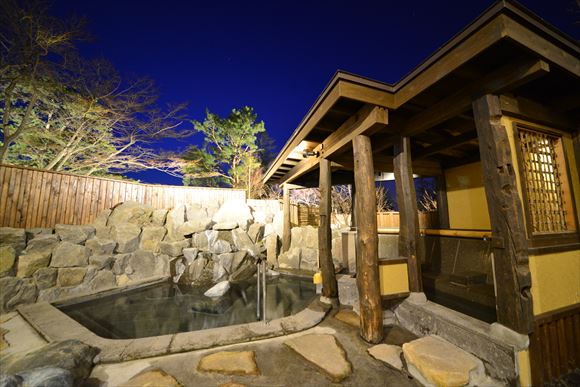 |
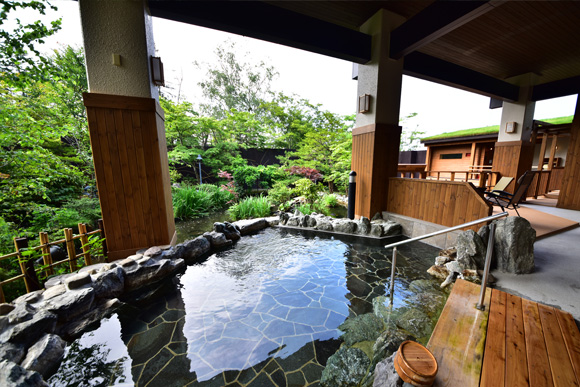 |
| The open-air bath in the large public bath "Iwa-no-Yu" is laid out with natural stones and has a wonderful ambience of wildness. 2 bathtubs are available, and a footbath is also provided. The indoor bath is also equipped with a bedrock bath. | The large bathtub has a great sense of openness with a Japanese garden spread out below. Depending on the season, you may hear frogs croaking in the background, giving you the feeling of being one with nature. |
| Private bath "Kokage-no-Ideyu" | Japanese/Western style special room "Kiri" open-air bath |
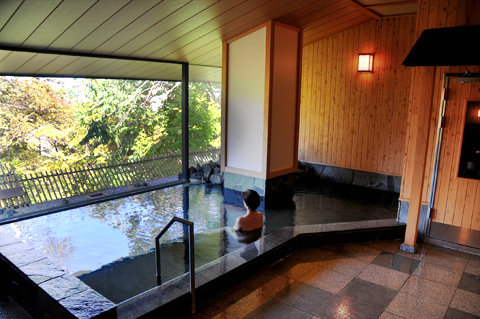 |
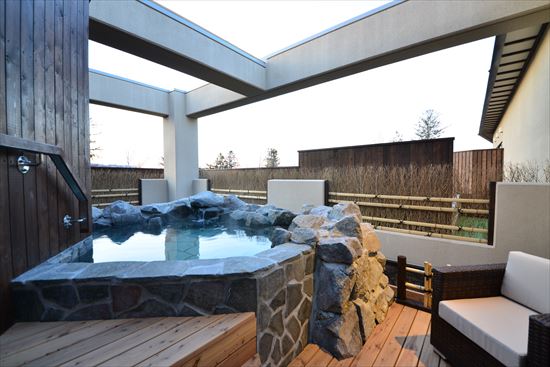 |
| This bathtub was originally a renewal of the large bath in the detached building, and its size is impressive for a private bath. The large windows can be opened to create a semi-open-air atmosphere. The Japanese garden, the pride of the ryokan, can be seen below. | Facing a lush garden, visitors can enjoy the scenery in each of the four seasons. Especially in winter, it is illuminated, creating a romantic atmosphere. The open-air baths on the open terrace offer an outstanding sense of spaciousness and luxury itself. |
Facility Report
Otaru City is considered a relatively warm place in Hokkaido. The ryokan Otaru Kourakuen is located at Otaru Asarigawa Hot Springs area, a 10-minute drive from downtown Otaru.
Although it is located in the city, the well-maintained garden spreads over a vast area of 8,000 tsubo (about 1,000 square meters), giving it quite a presence. Many of the trees in the garden are nearly 100 years old, and there is a wide variety of species. Upon entering the grounds, one finds a straight path leading to the entrance, lined with cherry blossom trees. It is said to be a famous spot among the locals, so much so that it is considered one of the best cherry blossom viewing spots in Otaru every season.
In 2016, the ryokan reopened after a renovations. Since the reopening, while maintaining support from local customers, customers from the Honshu area, neighboring countries such as China, Taiwan, and South Korea, and inbound customers from Thailand, Indonesia, and the Philippines have shown rapid growth. The number of visitors from North America and Europe is also on the rise.
Knowing this ryokan, it is easy to understand why it is so popular among foreign guests. This is because "Hokkaido's character" and "the goodness of Japanese ryokan" coexist here.
The spacious garden and cuisine full of seafood truly represent Hokkaido, while the calm atmosphere of the guest rooms and the quality of the hot springs are the essence of a Japanese onsen ryokan. The relaxing atmosphere of the guest rooms and the quality of the hot spring water is the essence of a Japanese onsen ryokan, and the baths, while enjoying the Japanese garden, which is unique to this ryokan, combined with the clean Hokkaido air, will surely lead you to a luxurious and healing time. It is also a good choice for an anniversary trip with your loved ones.
If had to sum up this ryokan in one word, it would be "serious". It is a relief to know that such a straightforward ryokan still exists. This may be sensed by most of the guests.
The founder, Mr. Seisaku Yoneyama, cultivated the land where nothing existed, one by one, built buildings, dug hot springs, and always thought sincerely about how to attract guests and what to do to make them happy. Furthermore, he never forgot his gratitude for being able to work in this land. It seems that this spirit is still carried on at the ryokan today.
Travel Journal
Rates Data
| Room with two meals | From 22,310 yen per night(without tax) |
|---|---|
| Room with breakfast | No settings |
| Overnight stay without meals | No settings |
| Private bath fee for overnight stay | 2,000 yen (without tax)(45min.) |
| Public bath fee for day trip | Adult: 741 yen Child: 371 yen (without tax) Only on Saturday/Sunday/Holidays |
| Private bath fee for day trip | 2,000 yen (without tax)(45min.) ※Reservations required up to the day before |
Facility Data
| Founded in | 1957 |
|---|---|
| Check in | 3:00 PM |
| Check out | 11:00 AM |
| Location of the ryokan | Garden |
| Number of rooms | 35 rooms total |
| Capacity | 134 people |
| Parking | 30 cars |
| Facilities | Lounge, cafe, spa, smoking room, banquet hall |
| Internet | Wi-Fi available |
| Handicapped-accessible rooms | Supported |
| Toilet with shower | Equipped |
Transportation Access
| By train | ●From JR New Chitose Airport Station
Take the rapid airport train bound for Otaru (approx. 80 min.) →JR Otaru Chikko Station
Approx. 10 min. by cab after train. ●From JR Sapporo Station Take the rapid train bound for Otaru (approx. 30 min.) →JR Otaru Chikko Station Approx. 10 min. by cab after train. |
|---|---|
| Shuttle bus | None |
| By car | Approximately 60 minutes from New Chitose Airport (from Chitose IC to Asazato IC on the Hokkaido Expressway) Approximately 40 minutes from Sapporo (to Asazato IC on the Hokkaido Expressway) Approximately 1 minute from the Asazato IC of the Sapporo Expressway |
| Address | Hokkaido/Otaru Asarigawa Onsen/Otaru Kourakuen 5-18-2 Shinko, Otaru City, Hokkaido, 047-0152 |
- Data
- 2024/01/18

